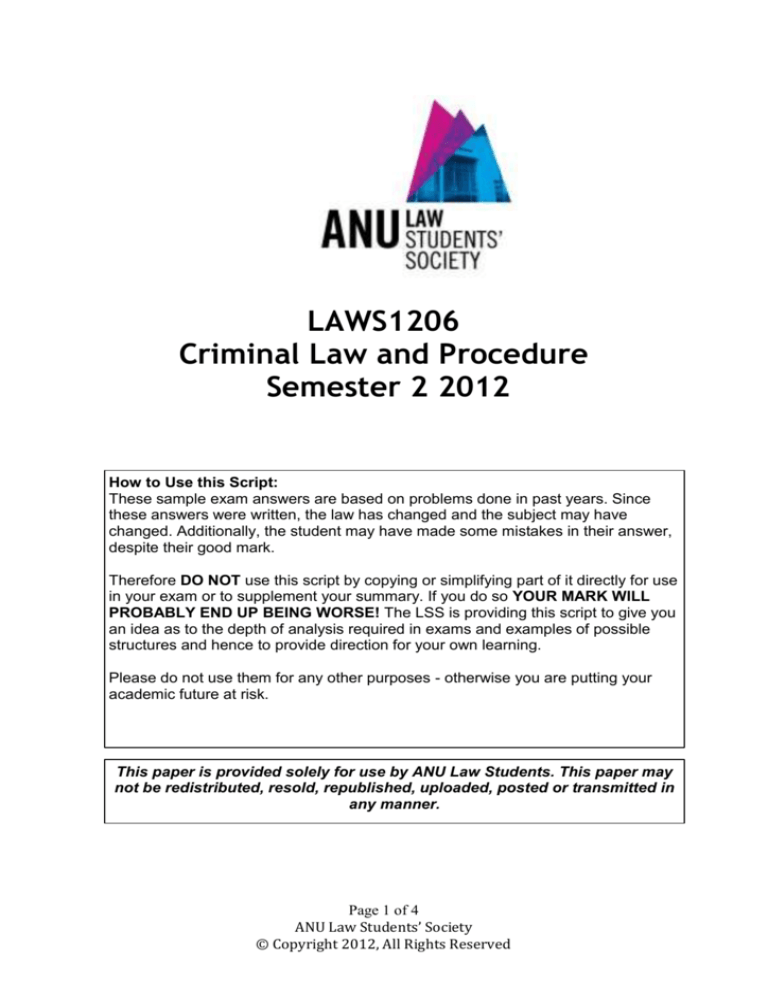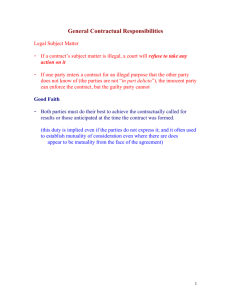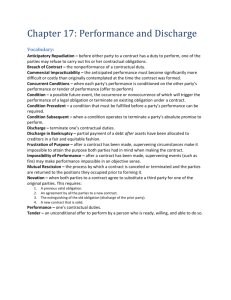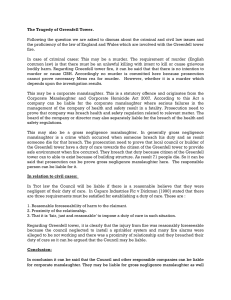
LAWS1206
Criminal Law and Procedure
Semester 2 2012
How to Use this Script:
These sample exam answers are based on problems done in past years. Since
these answers were written, the law has changed and the subject may have
changed. Additionally, the student may have made some mistakes in their answer,
despite their good mark.
Therefore DO NOT use this script by copying or simplifying part of it directly for use
in your exam or to supplement your summary. If you do so YOUR MARK WILL
PROBABLY END UP BEING WORSE! The LSS is providing this script to give you
an idea as to the depth of analysis required in exams and examples of possible
structures and hence to provide direction for your own learning.
Please do not use them for any other purposes - otherwise you are putting your
academic future at risk.
This paper is provided solely for use by ANU Law Students. This paper may
not be redistributed, resold, republished, uploaded, posted or transmitted in
any manner.
Page 1 of 4
ANU Law Students’ Society
© Copyright 2012, All Rights Reserved
a)
Q4.
The relevant conduct here took place in NSW and so the Crimes Act 1901 NSW
here applies . The prosecution will need to prove all elements beyond
reasonable doubt here (Woolmington) and I would so advise Denise (D).
S 18(1)(b) provides that every other punishable homicide is manslaughter and
so reference for both sections can be made to the common law (Lavender).
The prosection must first show that D’s actions caused B’s death.
Given that unlawful and dangerous act manslaughter (UDM) requires a positive act
(Wilson), the conduct will here be characterised as the putting of the TCAP ont eh
window sill in the first place as opposed to a failure to remove it (though this may be
relevant to part (b)). [Does this match up to the necessary act in the Explosives Act?]
That conduct was voluntary (Ryan).
Because B was the one to knock the glass over, the causation analysis needs to go
beyond one of the common sense (Campbell). But it will not be difficult to so prove it
because D’s action can be taken as being so connected as having substantial causal
effect and contribution, which did subsist up to the happening of the event (Hallet),
and although it was not the sale or immediate cause of death, D’s action created a
dangerous situation and must be taken as a substantial cause of B’s death (Royall).
The courts are reluctant to finding intervening acts (Pagett) and so this element would
likely be satisfied [When it’s the victim’s acts?]
UDM.
An unlawful and dangerous act must be proved beyond reasonable doubt (Larkin).
Unlawful Act
The unlawful act and its elements must first be provide (Lamb). That act is here a
breach of s 6 of the Explosives Act. D’s possessing and storing of the TCAP and
doing so without a licence, clearly satisfies the physical elements of s 6 .There is no
fault element for that provision, meaning it is a strict or absolute liability offence, but
even fi the presumption of mens rea (Sherras) [He Kaw Teh analysis?] were not
rebutted, given Victor was a chemist, it is likely that she knew a licence was needed
and knew she did not have one. If it were a crime of strict liability, she would likely to
be found to have merely adverted to the need to have a licence and so given all these
elements, it is likely that (writing unreadable) act would be found.
The act must be more than a mere breach of statutory regulatory provision and be
genuinely criminal (Pullman). This is likely to be found given leaving it around and
doing it often was a gross breach and in any case, the punishments for the crime (e.g.
6 months jail) moves it beyond being a mere breach to it being truly criminal. Good
use of facts.
Dangerous Act
Page 2 of 4
ANU Law Students’ Society
© Copyright 2012, All Rights Reserved
According to Wilson, the question to be here posed is as to whether ‘a reasonable man
in the A’s position, performing the Act which A performed, have realised that he was
exposing another or others to an appreciable risk of serious harm?’
good.
Wills provides that when considering ‘an appreciable risk’, the special knowledge of
the accused and the circumstances, including physical features, can be taken into
account.
Here, it is likely that a reasonable man in D’s position, when putting he explosive on
the window sill, would have known that he was exposing others to an appreciable risk
of serious injury. D had the special knowledge, given her years of talking and using
explosives with Victor that they were very harmful and could cause serious injury.
She was no stranger to their use or effect. Further, a reasonable person with that
special knowledge (Wills) would have realised there was an appreciable risk given the
very nature of households where people are often around and liable to move around .
It would have been unlikely therefore that a reasonable person would have put the
glass in such a position. This is a crime of basic intent and so no relevant intoxication
can be taken into account here (s 428D).
Conclusion
Given these findings, I would advise D that the prosecution’s case is likely to be
strong against her here.
b)
Criminal Negligent Manslaughter
The same causation issues as previously discussed so here apply, though given there
may be an omission here, it would likely be that the P will characterise the relevant
conduct as the failure of D to remove the TCAP in the dangerous situation it caused
and a potential duty coming about.
Nydam provides that this type of manslaughter will be established where the A caused
death in circumstances where A owed a duty of care to the victim and there was a
gross breach of the standard of care that a reasonable person with that duty would
have exercised and in the circumstances where there was a high risk that death or gbh
would result.
The duty here:
A duty here could potentially arise by way of a special relationship at common law,
potentially being analogous to a parent-child relationship (Russell). But in any case, a
duty is likely established, given that a duty comes about to remove a situation of
danger where oneself has created that situation (Miller). Here, she put the glass on the
window and was under a duty to remove it given she knew its danger after the
conversation.
Good.
Breach of the standard of care a reasonable person would have owed?
Yes, a reasonable person would not have left the substance there knowing that it could
be so harmful (specialist knowledge: Wills). It was a gross breach (Andrews), given
she did not only leave it there but did not warn B and showed a complete disregard to
human life (also did not bother to get Victor to remove it=gross breach).
Page 3 of 4
ANU Law Students’ Society
© Copyright 2012, All Rights Reserved
Circumstances of high risk of death/gbh were also present given the chemicals were
of such a dangerous nature and were in a very precarious place given the happenings
of a household.
No intoxication of the beers can be taken into account as basic intent (s 428D(i)).
Also s 428F ‘Reasonable’?
Conclusion
Given these elements I would advise D that the prosecution has a strong case and she
could potentially face 25 years imprisonment subject to s 21 of the Crimes Sentencing
Procedure Act.
Page 4 of 4
ANU Law Students’ Society
© Copyright 2012, All Rights Reserved







